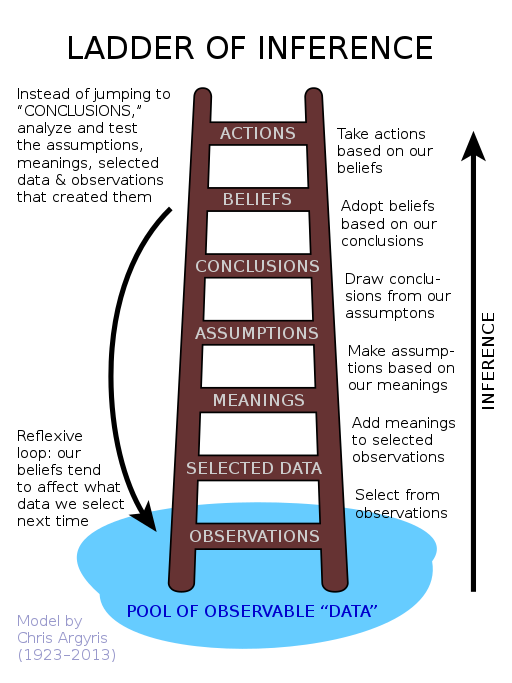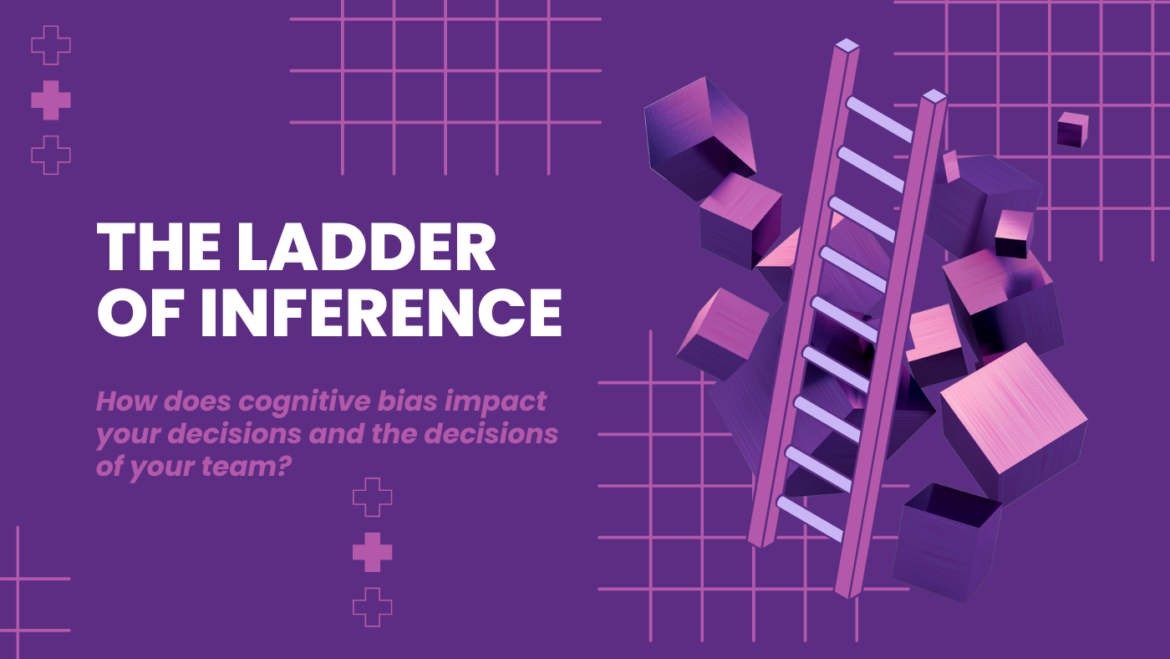The Ladder of Inference, developed by organizational psychologist Chris Argyris, is a model that explains how people make assumptions. It helps us become aware of how we draw conclusions based on incomplete or selective information. Additionally, this tool illustrates how individuals move from observable data to beliefs and actions through a series of rungs, akin to climbing a ladder. These include observing, selecting data, interpreting data, making assumptions, drawing conclusions, adopting/adapting beliefs, and taking action.

The Benefits of the Ladder of Inference
By understanding the steps involved in the inferential process, and by testing our assumptions, observations, and data, we can become more aware of our own cognitive biases and tendencies to jump to conclusions. This awareness leads to more accurate perceptions and more effective problem-solving. Studies have demonstrated that teams and leaders who incorporate the Ladder of Inference experience enhanced collaboration, reduced conflict, and increased innovation. Who wouldn’t want that?! Here are seven ways to use the Ladder of Influence for yourself and with your team.
1. Foster Awareness and Understanding
School and district leaders can start by familiarizing themselves with the concept of the Ladder of Inference. Read relevant literature and attend training sessions if possible. You may need to conduct workshops or training sessions for your leadership teams to introduce the concept of the Ladder of Inference. Facilitating group discussions to deepen understanding can also go a long way.
2. Promote Reflective Practice
Individual reflection can be encouraged through journaling or engaging in discussions with mentors or colleagues to identify cognitive biases. You can incorporate reflective practices into team meetings by dedicating time for group reflection on past decisions or interactions. This can help to uncover underlying assumptions and evaluate their impact.
3. Encourage Inquiry and Dialogue
Create a culture of open dialogue. Actively solicit input from team members, encouraging questions, and fostering an environment where diverse perspectives are valued. This may look like group discussions using techniques such as brainstorming or structured debates. These can encourage team members to explore different interpretations of data and challenge assumptions.
4. Model Transparent Decision-Making
As a leader, you can model transparent decision-making by clearly communicating the rationale behind decisions, sharing relevant information, and openly discussing the steps taken to arrive at a conclusion. In a team setting, you can involve team members in the decision-making process. Seek their input, explain the reasoning behind decisions, and invite feedback to ensure that all perspectives are considered.
5. Provide Tools and Frameworks
Learn from and provide team members with resources and tools, such as articles, books, or online courses. These resources can deepen their understanding of the Ladder of Inference and how to apply it in their work. The Ladder of Inference can be infused into team processes and procedures, such as decision-making protocols or project planning frameworks. This will ensure that it becomes an integral part of the team’s approach.
6. Embed in Professional Development
The concept of the Ladder of Inference can be incorporated into leadership development programs or coaching sessions for yourself and other leaders within the organization. Provide opportunities to practice applying the concept in your work when working with a team during professional development.
7. Evaluate and Reflect on the Impact
Assess the impact of integrating the Ladder of Inference into your work practices by soliciting feedback from team members, monitoring decision-making processes, and evaluating outcomes. Be sure to involve team members in the evaluation process. You can do this by gathering their input on how the use of the Ladder of Inference has influenced their decision-making, communication, and collaboration within the team.
Embedding the Ladder of Inference in work practices offers a reflective path to improved decision-making and team dynamics. By actively engaging team members in assessing its impact through feedback, observation, and outcome analysis, school leaders can foster a culture of thoughtful communication and collaborative problem-solving. Embrace this tool to navigate the complexities of team interactions and decision-making processes, ensuring that every step taken is grounded in awareness and shared understanding.

